Experimental aircraft Ryan Model 92 / VZ-3 Vertiplane (USA)
The American company Ryan Aeronautical began work on creating a promising aviation techniques with improved takeoff and landing characteristics in the fifties of the last century. With the help of some original technical solutions, both already known and completely new, it was planned to create an experimental aircraft with the required parameters. In the future, the technologies underlying the pilot project could find application in creating aircraft suitable for practical use. First of all, such a technique could interest the army.
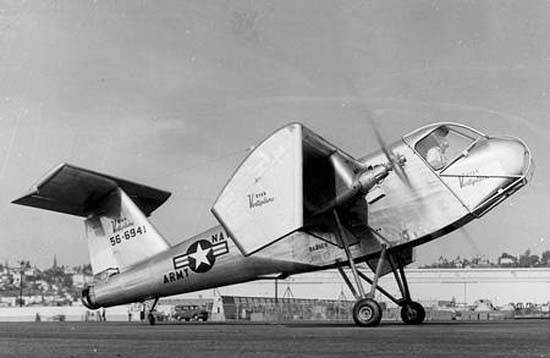
The first version of the aircraft Ryan VZ-3. Photo Airwar.ru
To reduce the take-off distance or to ensure vertical ascent into the air, different methods and designs of the aircraft can be used. In their new project, the designers of Ryan decided to apply the technology of deflecting the air flow. The wing of the aircraft of the new model was to be equipped with developed flaps of a large size that could have a significant impact on the movement of air, changing its direction and creating additional thrust.
To test the original proposal in practice was planned with the help of a specialized experimental aircraft. The new project received a working corporate designation Ryan Model 92. Subsequently, when the US Army showed its interest in the development, a new designation VZ-3 appeared, as well as the proper name Vertiplane. Also, from a certain time, the military name of the project was supplemented with new letters: VZ-3RY. It was under the army designation of the project became widely known.
The purpose of the V-Teplein project was the construction of an experimental aircraft with the possibility of vertical or shortened take-off and landing. It was intended for the practical testing of some original ideas, which made it possible to significantly simplify the design. The experimental aircraft was not supposed to carry a payload or carry weapon. As a result, it did not require high loading capacity and various special equipment. Only some elements of the airframe and power plant, directly related to the main objectives of the project, should have been distinguished by comparative complexity.
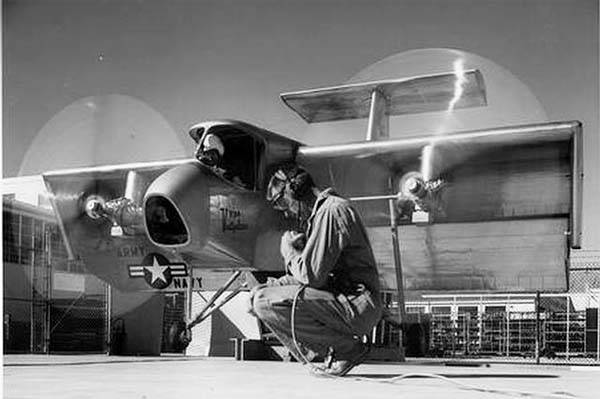
The prototype is on trial. Flaps are released, the area of the propeller disks is visible. Photo Airwar.ru
The VZ-3 aircraft was proposed to be made by a high-wing aircraft with two propellers on the underwing gondolas and a fixed chassis. He received the fuselage of a large, drop-shaped elongation. At the same time, the nose and central parts of the fuselage, distinguished by an enlarged section, had vertical sides and a horizontal bottom, smoothly mating with other surface areas. The tail boom had a tapering shape of a truncated cone. In the central part of the fuselage, flush with its upper surface, the wing of the original structure was attached. On the tail, it was planned to install a T-shaped tail unit with a small keel sweep and a rectangular stabilizer.
The nose of the fuselage accommodates the cockpit for a single pilot. In the first version of the project, the pilot was to fall into place through a large opening between the roof and the sides of the fuselage. During the flight, it was covered with a windshield mounted on a metal frame of complex shape. Even in the early stages of the project, it was established that such a cabin glazing design would not provide the required overview during takeoff and landing. Because of this, the fuselage received an additional window with glazing at the bottom of the nose fairing. With it, the pilot could follow the runway.
The main innovation of the Ryan VZ-3 project was an unusual wing with well-developed mechanization, which directly affects the main characteristics of the aircraft. In the central part of the fuselage, it was proposed to install a high-placed wing of a rectangular shape. The wing was distinguished by a small elongation, however, the other features of its design made it possible to fully compensate for this “flaw”. Also a characteristic feature of the carrier plane was a large profile thickness. Two small-sized gondolas with gearboxes and propeller shafts were placed under the wing. Large trapezoid shaped combs were used, with the help of which it was proposed to eliminate the overflow of the air flow and its exit beyond the limits of the required zone.
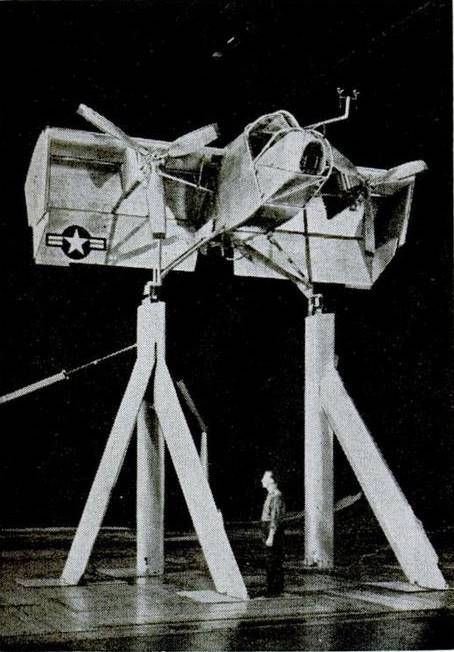
Tests "Vyoplein" in a wind tunnel. Popular Mechanics Photos
The wing of the experimental aircraft received large retractable flaps, the area of which was comparable with the dimensions of the bearing plane. To improve the take-off and landing characteristics, the flaps could be pulled out of the wing and lean back, taking a position close to the vertical. At the same time, the wing, flaps and tips-ridges formed a box-shaped system, designed to have a significant impact on the aerodynamics of the machine and properly redistribute the air flow. It was due to the redistribution of the flow and the direction of the air downward supposed to get a shortened or even vertical takeoff.
Experimental aircraft received an unusual power plant, equipped with two propellers. The Avco Lycoming T53-L-1 turbo-shaft helicopter engine, hp power 1000, was placed in the rear fuselage. The air supply was carried out using the intake device on the bottom of the fuselage and the internal channel of a small length, the fuel was supplied from the built-in tanks. In front of the engine there was a shaft that transmitted power to the central gearbox. This device distributes torque to two shafts that run parallel to the wing spars. Further, through several gears, power was supplied to the propellers.
Three-bladed propellers were fastened on the shafts emerging from the underwing gondolas. Thanks to the use of an unusual drive, the gondolas had the smallest possible size. Moreover, in their width they did not differ from the pylons on which they were installed. Thus, the protruding underwing aggregates blocked the minimum possible part of the area of the plane. Each propeller had a diameter of 2,79 m, due to which its swept disc covered almost the entire front projection area of the wing, positively affecting flight data.
The experimental aircraft of the new model had to have acceptable controllability in all flight modes, for which he received both traditional control surfaces and non-standard means of a similar purpose. Pitch and yaw control in the speed flight mode was planned to be carried out using the elevator and rudder placed on the stabilizer and keel, respectively. At low speeds, such devices sharply lost their efficiency, which, in addition to them, developed a system of gas rudders connected to the engine. The plane could not be completed with ailerons, for this reason, the roll control was proposed to be carried out by changing the operating parameters of the two propellers. An increase in the thrust of one of the screws caused the corresponding plane to rise upward under the action of the increased lift force and thus led to a change in roll.
The first version of the Ryan VZ-3 Vertiplane project involved the use of a three-point chassis with a tail wheel. The main pillars of such a chassis consisted of three tubes of different lengths, their wheels were located under the central part of the fuselage. The crutch was in the tail. The possibility of cleaning the chassis was not provided, since the aircraft had to have the lowest possible take-off weight.
The length of the aircraft of the first version was 8,3 m, wingspan - 7,14 m, height - 3,25 m. Normal take-off weight was determined in 1180 kg. To drive the car had to be the only pilot located in the bow cabin. Low take-off weight limited fuel, but high speed and range were not the goal of the project. The aircraft was supposed to show good take-off and landing characteristics.
The pilot project was completed in 1957 year. At the beginning of next year, the first prototype was presented for testing. February 7 he was taken to the airport, where they began ground tests. Before the first flight of the VZ-3, the testers carried out an extensive ground testing program. In addition, a full-fledged prototype was tested in a wind tunnel. All this work took a little less than a year. A considerable amount of information was collected about the behavior of the machine in different modes, and also determined the range of necessary improvements. According to the results of ground tests, an experienced aircraft was allowed to fly.
The first flight of the experienced “Vyoplein” took place on January 21 1959. The use of large flaps, together with the wing forming a box-like structure, gave certain results. In practice, it was confirmed the possibility of a sharp reduction in takeoff and run. At the same time, it was not without problems. First of all, it turned out that the 1000-strong engine does not provide the required thrust, which is why the plane needed a headwind for the correct takeoff with a minimum run-up. In addition, handling problems may have occurred in some situations.
The overwhelming number of test flights was intended to establish the real characteristics of the take-off and landing modes. The study of the behavior of the machine in the mode of horizontal flight was a minor task of work. As part of the test, it was found that the aircraft in its current form still cannot carry out a vertical take-off. Nevertheless, he had a good potential in terms of run-up and run reduction, although he could need “help” from the headwind.
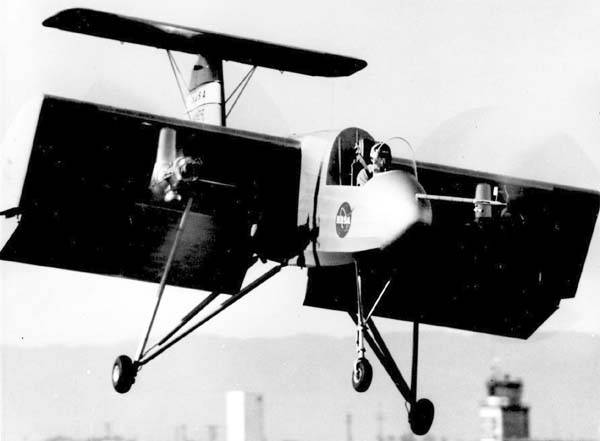
Updated car in flight. Photo Airwar.ru
In the first months of 1959, specialists from Ryan Aeronautical and the US Army managed to conduct only two dozen relatively successful test flights. During 21, the experimental VZ-3 fell and was damaged. They decided to restore the car and continue the tests. For a number of reasons, shortly after the accident and the start of repairs, the United States military lost interest in the unusual project and refused to continue to participate in it. However, the aircraft was still needed by science, because of which, after repair, the prototype was transferred to NASA. Further work was carried out by aerospace agency specialists.
The tests were resumed in February 1960, but soon stopped again. During the next ascent into the air there were problems that forced the pilot to leave the car. Fortunately, the aircraft again did not receive serious damage and could be restored. At the same time, the breakdowns and the repair that followed were an excellent reason for introducing a number of new solutions. The prototype was planned to not only be repaired, but also rebuilt according to the updated project. The proposed improvements were formed based on the results of ground and aerodynamic tests, as well as taking into account the experience of the first test flights.
First of all, the chassis has undergone serious processing. The design of the main racks was changed, and the tail crutch was replaced with a non-removable nasal strut. This led to a change in the position of the aircraft in the parking lot and during the takeoff run: now it had to stand exactly, lowering its nose a little. Recycling of the chassis allowed us to improve visibility at takeoff and landing, which is why the glazing was removed from the nose fairing. The cabin has lost its existing glazing and roof. Now only a small visor had to protect the pilot, there were no other elements of the flashlight. Part of the metal skin of the fuselage in the nose replaced linen.
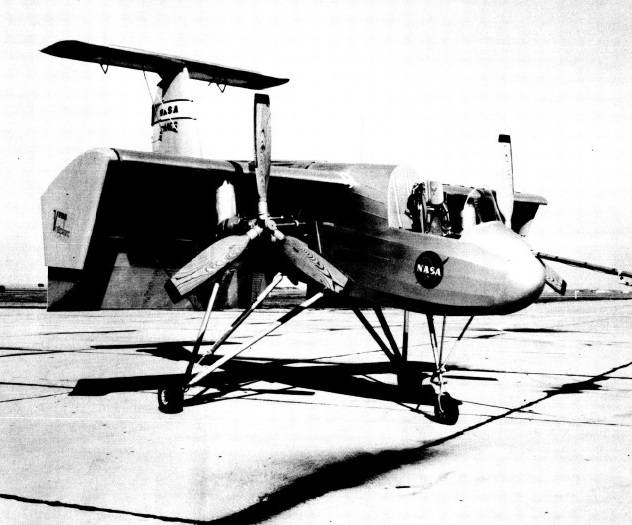
The release of flaps led to the formation of a characteristic box system. Photo of Wikimedia Commons
Measures were taken to change the aerodynamics of the aircraft. In place of the crutch under the fuselage, an additional comb appeared, which improves the stability along the course. To improve the characteristics of the wing deviated slats appeared on the plane. Also changed the size of the flaps. Other modifications were also used, the purpose of which was to simplify or improve certain elements of the aircraft, as well as to improve the aerodynamic parameters.
By the end of 1960, NASA experts again brought experienced Ryan Vertiplane to the runway. Inspections of the car continued until the 1961 year, their main goal was to study the take-off and landing characteristics with different wing configurations, controllability in different modes, etc. The characteristics of the aircraft in horizontal flight were checked several times. In the course of several stages of testing, separated by repairs, a large amount of diverse information was collected.
The prototype VZ-3 was tested at speeds from 6 nodes (11,1 km / h) to 80 nodes (148,1 km / h) and showed acceptable performance throughout this range. Optimum take-off and landing parameters were achieved in the 20-25 knots range (37-46 km / h). So, at speeds of about 35 km / h, the aircraft required the entire 9-10 m to run - slightly more than its own length. At this speed, the aircraft, while maintaining lift, could rise to an altitude of 1,1 km.
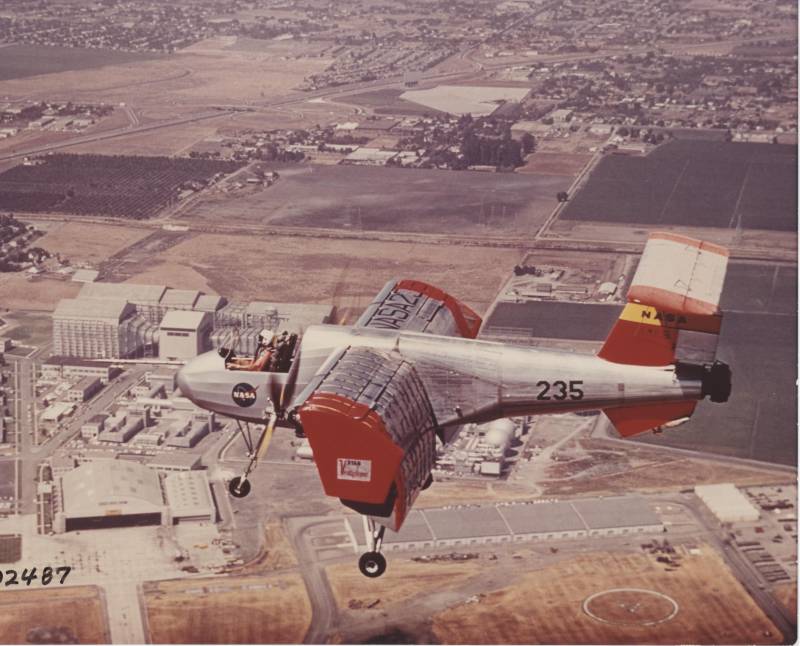
VZ-3 aircraft with flaps released could climb to a sufficiently large height. Photo of Wikimedia Commons
Already in the early stages of testing, the pilots had to deal with the so-called. ground effect. At altitudes of less than 5 m, the air currents reflected from the ground began to negatively affect the operation of the propellers and the wing, reducing their efficiency. In addition, the stability of the aircraft deteriorated, which could lead to a spontaneous transition into a dive and a fall. Incorrect use of gas rudders at the same time led to increased risks. The negative impact of the underlying surface is particularly hampered the implementation of the landing. Nevertheless, recommendations were soon formed on the optimal modes of descent and touching the ground.
To avoid loss of control and fall, the pilot on landing, dropping below 15 feet (5 m), had to withstand speeds around 20 nodes. The angle of descent should be kept at several degrees. During the experiments, it was possible to increase the landing speed to 40 nodes (74 km / h) and the angle of descent to 16 °, but such landing modes were associated with serious risks.
Even at the stage of blowing in the wind tunnel, it was found that the Ryan VZ-3 Vertiplane, despite its name, would not be able to take off and land vertically. Full flight tests confirmed this conclusion. Nevertheless, the authors of the project managed to get a significant reduction in the length of the run-up and run, which was also a good result and corresponded to the original goals of the work.
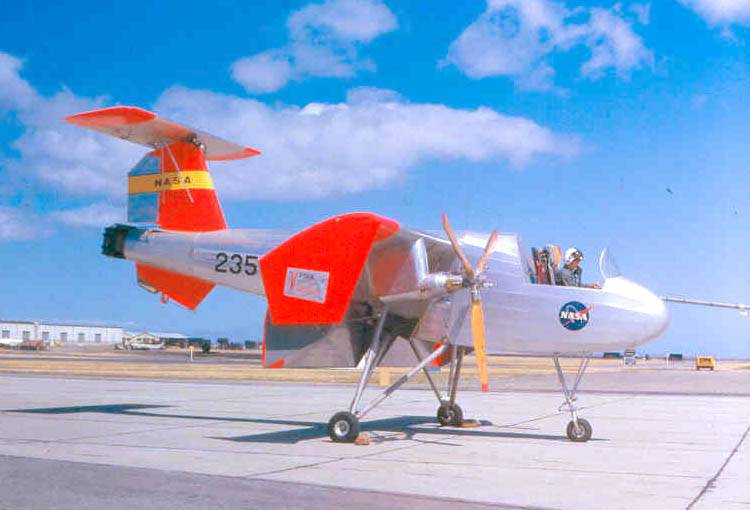
The only prototype built by Ryan Vertiplane in color NASA. Photo of Wikimedia Commons
Tests of the prototype rebuilt according to the updated project continued until 1961. For some time after their completion, American experts analyzed the data collected and issued various reports. A complete study and understanding of the collected data took several years and became the subject of many reports, scientific works, etc. The prototype itself had already been sent to storage by this time and had almost no chance of resuming flights.
Indeed, after 1961, the experienced VZ-3 never went up in the air. After all the required research and scientific works were completed, the car was decommissioned as superfluous. Unlike some other unique samples of aviation technology, the only "V-Teplein" was not dismantled for metal. The aircraft was handed over to the Army Aviation Museum of the United States Army Aviation Museum (Fort Rucker, Alabama), where it remains to this day.
It should be noted that the prototype Ryan Model 92 / VZ-3 Vertiplane was not the only platform to test and refine original ideas aimed at improving the take-off and landing characteristics of the aircraft. During the fifties, similar-purpose machines were developed and tested by several other US aircraft manufacturers. Like the VZ-3, they are worth a separate review.
On the materials of the sites:
http://airwar.ru/
http://vertipedia.vtol.org/
http://aviadejavu.ru/
http://aviastar.org/
Vertiplane Really Puts Flaps Down. Popular Mechanics. April 1960
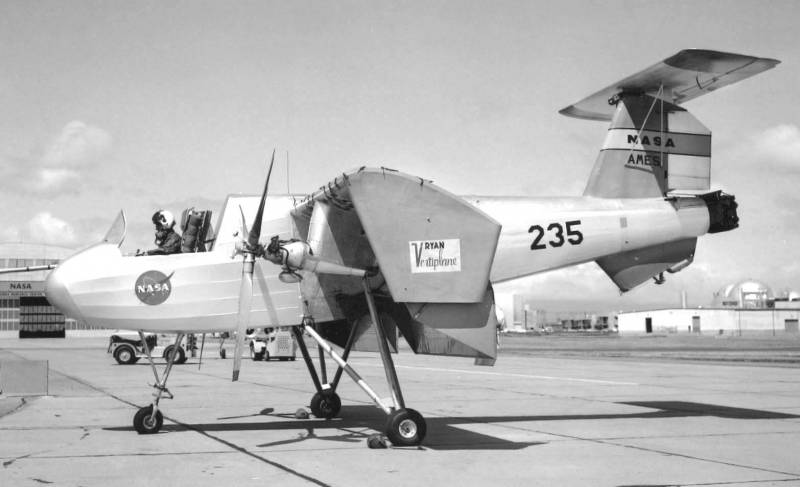
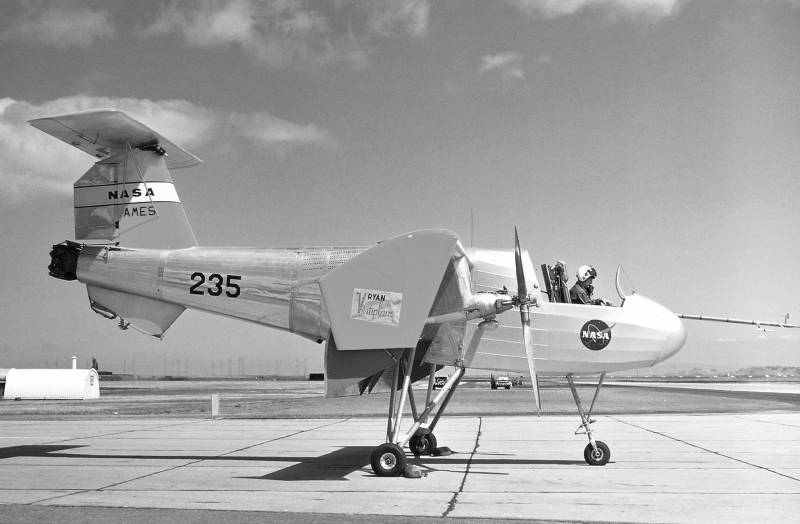
Information